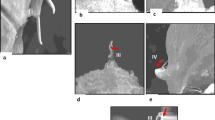Abstract
Forty one sites in mango gardens located in different districts of southern Karnataka were selected for the study during September 1984. Rate of surface cast production, earthworm density and species composition of each site were recorded and compared in relation to the soil moisture, pH, temperature, organic matter and soil type of each site. Only 19 out of the 41 sites examined showed surface casting. Rate of surface cast production is dependent on soil, pH, temperature, soil type and organic matter content. The bulk density of the soil established a direct linear correlation, and the field capacity of soil, a perfect U-shaped (parabolic) relationship with the rate of surface cast production. Sandy loams had greater species diversity as well as population density than the clays. Worms were not found in heavy sands and acid soils. Positive correlations were obtained between organic matter and species diversity or density; other factors were poorly correlated. A positive correlation between the cast output and the relaxed length of the worm was obtained. It is discussed that the field capacity and bulk density of soils are the determining factors for variations in surface cast production.
Similar content being viewed by others
References
Bennett D P and Humphries D A 1974Introduction to field biology 2nd edition (London: Edward Arnold Ltd.)
Brady N C 1974Nature and properties of soils 8th edition (New York: MacMillan Publishing Company)
Bostrom U 1986 The effect of soil compaction on earthworms (Lumbricidae) in a heavy clay soil;Swed. J. Agric. Res. 16 127–141
Cook A G, Critchley B R, Critchley U, Perfect T G and Yeadon R 1980 Effects of cultivation and DDT on earthworm activity in a forest soil in the sub-humid tropics;J. Appl. Ecol. 17 21–29
Crossley D A, Reichle D E and Edwards C A 1971 Intake and turnover of radioactive cesium by earthworms (Lumbricidae);Pedobiologia 11 71–76
Dash M C 1978 Role of earthworms in the decomposer system; inGlimpses of ecology (eds) J S Singh and B Gopal (Jaipur: International Scientific Publications) pp 399–406
Dash M C and Patra U C 1977 Density, biomass and energy budget in a tropical earthworm population from a grassland site in Orissa, India;Rev. Ecol. Biol Sol. 14 461–471
Edwards C A and Lofty J R 1977Biology of earthworms 2nd edition (London: Chapman and Hall Ltd.)
Evans A C and Guild W J and Mc L 1947 Studies on the relationships between earthworms and soil fertility, I. Biological studies in the field;Ann. Appl. Biol. 34 307–330
Guild W J 1955 Earthworms and soil structure; inSoil zoology (ed.) D K McEvan (London: Butterworths) pp 83–98
Habibullah A M and Ismail S A 1985 Preference to soil fractions and the effect of soil compaction on the casting and burrowing behaviour of the earthwormLampito mauritii;Indian J. Soil Biol. Ecol. 5 26–32
Hartenstein R 1983 Research needs—Sludges and invertebrates show, inSoil absorption of wastewater (Colorado: Colorado State University) pp 50–63
Hutchinson K J and King K L 1980 The effects of sheep stocking level on invertebrate abundance, biomass and energy utilization in a temperate sown grasslands;J. Appl. Ecol. 17 369–387
Jefferson P 1958 Studies on earthworm of turf. C. Earthworms and casting;J. Sports Turf Res. Inst. 9 437–452
Kale R D and Krishnamoorthy R V 1981 What affects the abundance and diversity of earthworms in soils? Indian Acad. Sci. (Anim. Sci.)90 117–121
Kollmannsperger F 1956 Lumricides of humid arid regions and their effect on soil fertility;VI Congr. Int. Sci. Sol. Rapp. C. 293–297
Krishnamoorthy R V 1985 A comparative study of wormcast production by earthworm populations from grassland and woodland sites near Bangalore, India;Rev. Ecol. Biol. Sol. 22 209–219
Krishnamoorthy R V 1989 Effects of agricultural practices on tropical earthworm populations of Bangalore, India;Pedobiologia (in press)
Lakhani K H and Satchell J E 1970 Production ofLumbricus terrestris L;J. Anim. Ecol. 39 473–492
Lavelle P 1984 The soil system in the humid tropics;Biol. Int. 9 2–27
Lee K E 1983 Earthworms of tropical regions—Some aspects of their ecology and relationship with soils; inEarthworm ecology from Darwin to vermiculture (ed.) J E Satchell (London: Chapman and Hall) pp 179–193
Mirajkar M A, Sresty D S and Shamacharya K 1979Soils of Karnataka and their fertility status (Bangalore: Karnataka State Department of Agriculture)
Piearce T G 1984 Earthworm populations in soils distributed by trampling;Biol. Conserv. 29 241–252
Reynoldson T B 1966 The ecology of earthworm with special reference to North Wales habitats;Welsh Soils Discussion Group Report No. 7, Soil Flora and Fauna pp 25–32
Satchell J E 1967 Lumbricidae; inSoil biology (eds.) A Burges and F Raw (London: Academic Press) pp 259–322
Senapati B K, Dash M C, Rana A L and Panda B K 1980 Observations on the effect of earthworm in the decomposition process in soil under laboratory conditions;Comp. Physiol. Ecol. 5 140–147
Snedecor G W and Cochran W G 1967Statistical methods 6th edition (Iowa: Iowa State College Press)
Stephenson J 1923Fauna of British India: Oligochaeta (London: Taylor and Francis) pp 593
Stephenson J 1930Oligochaeta (Oxford: University Press) pp 978
Thompson A J and Davies D M 1974 Production of surface casts by the earthwormEisenia rosea;Can. J. Zool. 52 659
Author information
Authors and Affiliations
Rights and permissions
About this article
Cite this article
Krishnamoorthy, R.V. Factors affecting the surface cast production by some earthworms of Indian tropics. Proc. Indian Acad. Sci. (Anim. Sci.) 98, 431–445 (1989). https://doi.org/10.1007/BF03179656
Received:
Revised:
Issue Date:
DOI: https://doi.org/10.1007/BF03179656




